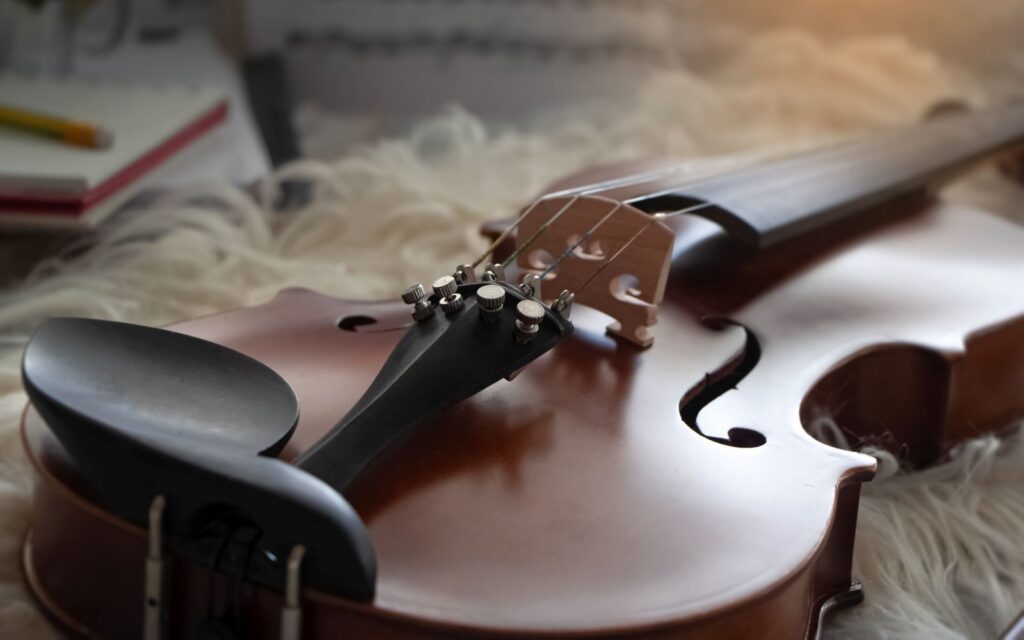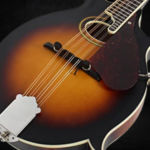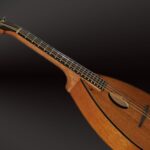When I first started playing the violin, the only choices for violin tuners were a pitch pipe or a tuning fork. I’m told that really expensive strobe tuners existed then, but it wasn’t something I knew about.
Over the years, technology has gotten much cheaper and more accessible to all players! Today’s violinists have the ability to get a top tuner for a great price.
Quick Look: Best Violin Tuners
★ #1 Best Violin Tuner Overall: Peterson Strobe Tuner ★
- Best Cheap Violin Tuner: Korg Chromatic Tuner CA-2
- Best Violin Tuner for Beginners: D’Addario NS Micro Violin Tuner
- Best Clip-on Tuner: D’Addario NS Micro Violin Tuner
I’m not looking at phone apps today, but only a variety of freestanding tuners for you to tune your violin with. I’ll help you decide what sort of tuner you want to buy and what you’re looking for in that tuner.
What Is a Violin Tuner?
A violin tuner will help you get your violin strings in tune. There are a lot of technical concerns and worries about tuning, but if you’re looking for a simple explanation, that’s it.
I’m not the person to explain super technical jargon about tuners to you, I’m the “keep it simple” person who will just tell you what you need to know.

You want a violin tuner that, when you play your A string, will tell you if it’s in tune, flat or sharp. And then you can play your other strings and get them in tune as well. If you’re a beginner, that’s where you’ll stop, and if you’re more advanced, you’ll probably only tune your A string and tune the rest by ear.
Types of Violin Tuners
You may decide you need more than one kind of tuner, so it’s important to know the different kinds. Some of the kinds overlap; for instance, you could have a clip-on strobe tuner.
Strobe Tuner
A strobe tuner is the most advanced way to tune your instrument. This is a great tuner for more advanced or professional players who are really looking to tune to the utmost precision and who want a better sense of how each note fits into the harmonic series.
Digital Tuner
A more basic tuner will just tell you flat or sharp, and that’s plenty for more beginning and intermediate players. You don’t want too much information, you just want to get your instrument in tune for your practice session or lesson.
You can look for an LED or LCD screen, and most of these have a “needle” that shows you if you’re flat or sharp as well as telling you what note you’re playing.
Clip-on Tuner
A clip-on tuner clips onto your violin, maybe at the shoulder or the pegbox. It’ll help you tune in a louder place.
Freestanding Tuner
I made up this term, but a freestanding tuner is one that you place in front of you and play into. Some freestanding tuners have a clip-on option that you can plug in and clip to your bridge.
Tuner App on Your Phone or Another Device
You can get a tuner app instead of purchasing a tuner, but I’m not going to go into that today, because I think it’s a post for another day!
Things to Consider When Choosing a Violin Tuner
If you’re looking for the best violin tuner, you’ll want to make sure you know what to look for.
Size
Most tuners are pretty small, and you’ll want something you can fit into your case so you can bring it with you wherever you go. If you don’t travel much or always carry a bag as well, this is less of a concern.
Features
Some tuners only do one thing, listen to your note and tell you if it’s in tune. Other tuners can also produce sounds for you to hear, and others double as a metronome.
You’ll also want to decide if you want a clip-on tuner or if a freestanding tuner will work for you. If you tend to use a music stand when you practice, a freestanding tuner will work well.
Range and Calibration
You’ll want to make sure that your tuner will be able to “hear” your strings. Without getting too technical, you should be aware the strings on a violin are typically tuned as G3, D4, A4, and E5, and that the A string is typically tuned to A440-442 hertz.
If you play up high a lot, you’ll want to make sure those pitches will be heard. If you play in a baroque style of music, you’ll want to make sure you can tune to a lower A.
If you want to have different temperament options, look for that as well, such as equal, just, pythagorean, or mean-tone. If you’re just getting started, don’t worry about what I just said.
Price
You can expect to pay between $10 and $130 for a tuner that I’m going to recommend to you. If you’re on a budget, there are several options under $30.
Battery
You’ll want to make sure your tuner has a battery and that the battery lasts as long as you need it to. Some tuners use a lithium battery, while others run on AAA batteries. Some are rechargeable.
Some have battery saving modes, where if you forget to turn it off it won’t run down your battery. In any case, decide what’s important to you.
10 Best Violin Tuners
 1. Mugig Clip-on Tuner
1. Mugig Clip-on Tuner
- Size: 3.30 x 1.10 x 2.10 inches
- Weight: .8 ounces
- Range and calibration: B0-B7, A4 calibration is 430-450 Hz
- Quick look: Clip-on tuner, different modes for different instruments, color display
- Best for: Beginners, intermediates, those wanting something easy to use
The Mugig is a top-selling tuner on Amazon due to its great price and features. It’s a clip-on tuner, and it’ll give you the basics that you need if you’re just getting started.
✅ Easy to use
✅ Lightweight
✅ Easy-to-read display
✅ Five different modes, can adjust hertz as well
❌ Can’t set up different styles of tuning
❌ Clip-on always has a risk of damaging the instrument
Why I Recommend It
The Mugig is a great basic tuner for you if you’re just getting started and want something easy to use and easy to understand. You won’t get too many fancy features, but you won’t need them for the price.
 2. Crescendo Zen Tuner
2. Crescendo Zen Tuner
- Size: 6 x 3 x 2.2 inches
- Weight: 3.2 ounces
- Range and calibration: A0-C8, A4 calibration 430-450 Hz
- Quick look: Easy-to-read display, easy to use, battery saving mode
- Best for: Beginners, intermediates, people who need to tune quickly in a loud setting
The Crescendo Zen Tuner is another clip-on tuner. They’re great for people who need to tune in a loud setting such as onstage with a band or during a gig. This is heavier than the Mugig, but it’s very sturdy and well made.
✅ Large display screen
✅ Battery saving mode kicks in automatically
✅ 360 degree rotation
✅ Clips on easily and securely
❌ Only does one thing, tells you if you’re in tune
❌ Might scratch violin finish if you aren’t careful
Why I Recommend It
The Crescendo Zen Tuner has fantastic reviews, and people love how easy to use it is and how long it lasts. This is a sturdy violin tuner that you can use for years. It tunes well and quite precisely, and it’s easy to see.
 3. Snark ST-8
3. Snark ST-8
- Size: 3.50 x 1.80 x 1.80 inches
- Weight: 1.5 ounces
- Range and calibration: 415-460 Hz
- Quick look: Digital display, clip-on tuner, battery operated
- Best for: Fiddlers, electric violinists, beginners/intermediate players
The Snark ST-8 is the updated version of a variety of older tuners. It’s small and compact, but it’s still easy to read the display.
✅ Small and compact
✅ Boots up quickly
✅ Stays on securely
✅ 360 degree swivel head
❌ Could damage violin finish
❌ Some reviewers complained the clamp broke
Why I Recommend It
The Snark is a good small tuner that works well. It’s easy to use and will stay securely on your instrument.
 4. Korg TM60BK Tuner and Metronome Combo
4. Korg TM60BK Tuner and Metronome Combo
- Size: 6.25 x 5.20 x 1.35 inches
- Weight: N/A
- Range and calibration: C1-C8, 410-480 Hz
- Quick look: Optional clip-on tuner attachment, includes metronome, can play notes as well
- Best for: Advanced, professionals
This Korg Tuner Metronome Combo will give you tons of features. I love having one machine to help you with all of your musical problems.
✅ Precise tuning
✅ Battery saving mode
✅ Tons of features
✅ Easy-to-read display
❌ May be confusing for beginners
❌ Heavier than a clip-on tuner
Why I Recommend It
If you’re a more serious student or a professional, I recommend getting a tuner more like this so you have more features than a basic clip-on. You can play notes back, and you have a metronome. What more does a player need?
 5. Korg Chromatic Tuner CA-2
5. Korg Chromatic Tuner CA-2
- Size: 3.30 x 1.00 x 4.30 inches
- Weight: .7 ounces
- Range and calibration: 410-480 Hz
- Quick look: Easy-to-use, basic freestanding tuner
- Best for: Beginners, intermediates, anybody wanting a basic violin tuner
This is a great basic Korg Chromatic Tuner CA-2 violin tuner. I’ve used a variety of Korg products over the years and I recommend them highly.
✅ Easy to use
✅ Plug-in option
✅ Works quickly and accurately
✅ Lightweight
❌ Difficult to hold
❌ May accidentally press buttons
Why I Recommend It
If you want a Korg tuner, this is the most basic model, and it will work well for many violinists. I love that you can just set it up on your stand and play into it, and the violin tuner will show you with a needle if you’re flat or sharp.
 6. Tetra-Teknica Essential Series EMT-800
6. Tetra-Teknica Essential Series EMT-800
- Size: 4” x 2.5” x 0.7”
- Weight: 2.8 oz
- Range and calibration: A0-C8, tuning range 430-450 Hz
- Quick look: Freestanding tuner/metronome combo
- Best for: Anybody looking for a budget option tuner/metronome
The Tetra-Teknica Essential Series EMT-800 is a great tuner/metronome combination for those on a budget. It may not last as long as a Korg tuner, but it might, and then you’ve saved some money.
✅ Good value
✅ Plays tones as well as tuner and metronome
✅ Plug-in option
✅ Uses standard batteries
❌ Can be slower to pick up on the note
❌ No low battery indicator
Why I Recommend It
This is a great value, and the reviews are mostly positive. If you want a budget option for a tuner and metronome together, the Tetra-Teknica violin tuner is a good option.
 7. Peterson StroboPlus HD Desktop Strobe Tune
7. Peterson StroboPlus HD Desktop Strobe Tune
- Size: 4 x 4 x 6 inches
- Weight: 1 pound
- Range and calibration: 12 octave range
- Quick look: Most precise tuner available
- Best for: Professionals
If you need precision and accuracy in your tuning to the 1/1000th of a cent, a Peterson StroboPlus HD Desktop tuner is best for you. This is what piano tuners use, and any serious violin player should consider investing in this tuner.
✅ Very accurate tuning
✅ Metronome combo option available
✅ Many different tuning system options available
✅ Great customer service
❌ Steeper learning curve
❌ Heavy
Why I Recommend It
I don’t own a strobe tuner, but I wish I did. If or when I buy one, this will be what I buy.
 8. D’Addario NS Micro Violin Tuner
8. D’Addario NS Micro Violin Tuner
- Size: 1.3 x 4 x 5.8 inches
- Weight: .12 ounces
- Range and calibration: 410-480 Hz
- Quick look: Clips onto the shoulder of the violin, easy-to-read display
- Best for: Beginners, people who want to keep the tuner on their violin longer, tuning in loud spaces
The D’Addario NS Micro Violin Tuner is a great option for players who want the convenience and ease of a clip-on but also want something that sits more easily on the shoulder of the violin. This is a lightweight tuner that’s easy to use and works well.
✅ Stays secure on the violin shoulder
✅ Picks up vibration rather than sound
✅ Lightweight
✅ Swivel head
❌ Only fits on violin or viola
❌ Still may damage the finish
Why I Recommend It
I have a few students who love this tuner, and they find it very easy to read and use. If you want something that stays on the violin shoulder rather than clipping onto the pegbox, this is a great option.
 9. Korg OT-120 Orchestral Tuner
9. Korg OT-120 Orchestral Tuner
- Size: 3.75” x 5.75” x 2.5”
- Weight: 10.6 ounces
- Range and calibration: A0-C8, 349-499 Hz
- Quick look: Lots of features, wide range of tuning options
- Best for: Professionals, advanced students, orchestral players
The Korg OT-120 is a high end tuner for more serious musicians. It has several tuning options and can even transpose notes, not that violinists worry about that, but it’s useful if you play more than one instrument.
✅ Many tuning options
✅ Precise tuning capability
✅ Can produce tones
✅ LED display
❌ More features: harder to understand
❌ Display screen is a little small
Why I Recommend It
The Korg OT-120 is a fantastic tuner from the Korg company. If you want a tuner that will tune in several different temperaments and has tons of features, this is it. It’s also quite accurate and well made.
 10. KLIQ MetroPitch
10. KLIQ MetroPitch
- Size: 4.3″ x 2.4″ x 0.6″
- Weight: 3.2 ounces
- Range and calibration: 410-480 Hz
- Quick look: Freestanding tuner/metronome combo with different color choices for the exterior
- Best for: Intermediate to advanced students
The Kliq Tuner is a decent deal with a wide range of tuning possibilities. I like that it has color options for those who are more fashion minded.
✅ Includes a metronome
✅ Wide range
✅ Easy to use
✅ Battery saving mode
❌ Can be a little slow
❌ No start-stop button on metronome mode
Why I Recommend It
I included this tuner-metronome combo because I like the look of it and it has good reviews. As a teacher, I struggle to convince my students to actually USE their tuners and metronomes, and I think having something in a cool color might encourage use!
It also works quite well and has a wide range of tuning options and features.
Best Violin Tuner Brands
As with any product, some brands are better than others. The ones here are good brands with a variety of tuning products to check out, including some that I haven’t listed.

Peterson
Peterson has been making tuners since 1950 and strobe tuners since 1967, though the technology has changed quite a bit since then. This is a great company with quality products and great customer service.
Korg
Korg is a Japanese company that makes a variety of musical products including tuners and metronomes. I’ve used many of their products over the years and can speak to the quality and customer service.
D’Addario
D’Addario makes a wide range of products, such as tuners, strings, rosin, and more. The company is Italian in origin and started as a string making company, but now is primarily headquartered in the US and England.
Violin Tuner Brands to Avoid
I don’t have specific brands to avoid, but I always recommend reading the reviews and checking the ratings. While you may not care about the same things as some reviewers, if a product has consistently bad reviews, I’d consider that a red flag.
How Much Do Violin Tuners Cost?
Violin tuners usually cost between $10 and $30 for the average tuner, and some high-end models are up to $130. No matter what your budget is, you’ll find the best violin for you.
What Are the Best Violin Tuners?
Below are what I consider the best violin tuners available today.
Peterson Strobe Tuner: Best for Professional Musicians
The Peterson Tuner is the top tuner for those needing precision tuning down to the micro cent.
Korg Chromatic Tuner CA-2: Best for Beginners
This is the easiest and cheapest freestanding tuner to use.
D’Addario NS Micro Violin Tuner: Best Clip-on
This is the best clip-on tuner for a violinist.
Where to Buy Violin Tuners
It’s pretty easy to buy violin tuners online if that’s how you like to shop. You can also go to a local music store and they should have what you need (or be able to special order it).
Amazon
Amazon has a bunch of different options. Do read the reviews because on occasion you’ll get a seller who seems to be selling old models and you probably want the newest model. They have great customer service, shipping and returns policies.
Online Music Retailers
Sweetwater.com, Fiddlershop.com and Guitarcenter.com have good online purchasing options, with lots of different tuners. There are many other online retailers as well, and just do your due diligence in determining if they’re legitimate with good shipping and return policies.
Your Local Music Store
If you have a local music store, it’s a good place to try things out and get personalized recommendations. It’s also really great to support small businesses and get to know a place nearby where you can get something on very short notice.
Review This Post
Table of Contents
In Conclusion
I hope this answered some of your questions about which violin tuners are the best and what to look for when shopping for a tuner for your violin. There are many options, and every year something new and possibly better comes out, as it is with all technology.
The main thing to remember is that the best tuner for you is the one that you will use. If it has too many features and it confuses you, you won’t use it. If it doesn’t have the feature or features you need, you won’t use it.
Buy what will work best for you. Please comment below and tell me what kind of tuner you use, and please share this post with your friends.














